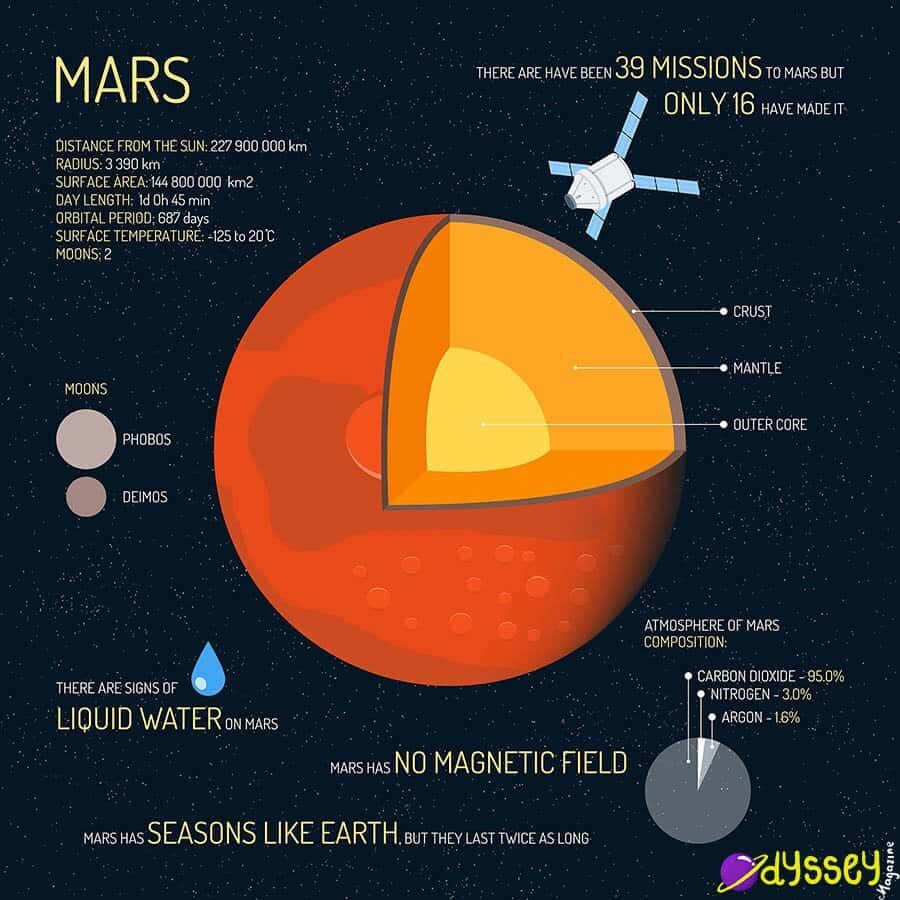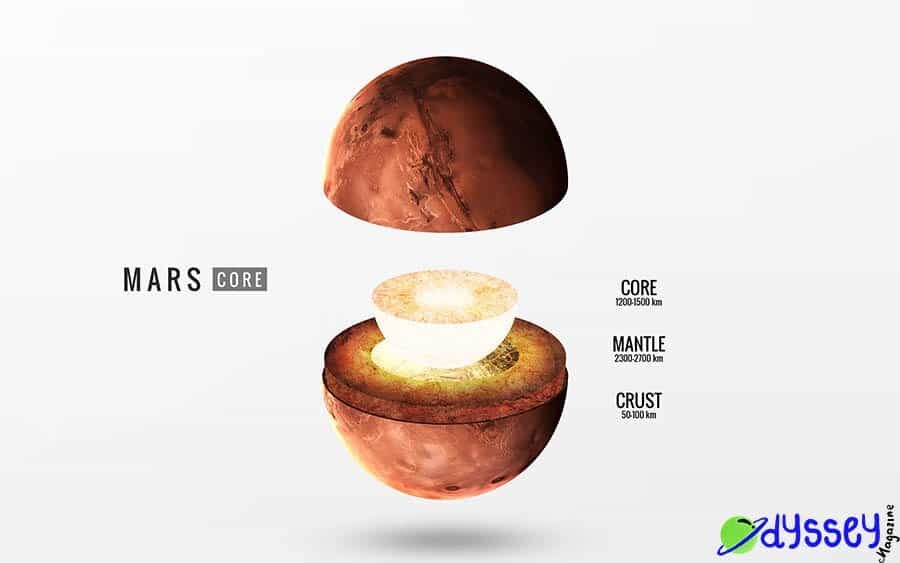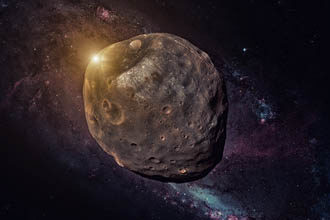23 Mars Facts | Exciting Facts about the planet Mars
In recent years, going to Mars has become more and more achievable. What was once a pipe dream is now likely to become a reality in the next decade, as we know more about Mars than ever. And whilst the planets closer to the Sun would fry us to death, and the gas and ice giants are unliveable, Mars seems like it might be a potential home for humans in the distant future.

There are many different Mars facts out there for us to learn about. The fourth planet from the Sun has had over 50 missions sent there, and today Mars remains one of NASA’s main focusses for the coming years. The red planet is thought to be the most likely planet that humans could live on if Earth were to cease to exist. So, let’s take a look at some facts about the planet Mars.
- Mars has a radius of 2106 miles (3389km). This is just over half the size of the Earth, and less than 1/20th of the size of the Jupiter.
- Mars is the fourth planet from the Sun, behind Mercury, Venus and the Earth.
- Aside from Earth, Mars is the planet that astronomers know the most about.
- We first landed a spacecraft on Mars all the way back in 1971 – however, this was a crash landing. Astronomers landed a second spacecraft safely just a month later, but the broadcast was interrupted after 15 seconds.
- One of our main objectives is to get a human person to Mars. The target year for this is by the the 2037, according to NASA.
- Mars is a red color. This is due to the high amount of iron oxide in the Martian soil.
- Mars has a distance from the Sun of around 141 million miles (228 million km). The average distance from Earth to Mars is around the same.
- Mars has the most similar day length to Earth, with a full day lasting 24 hours, 37 minutes, and 22 seconds.
- However, a full year on Mars takes 687 days. This is how long it takes to orbit the Sun.
- Mars has 4 different seasons, the same as Earth does. But because the amount of days in a year on Mars are around twice that compared to Earth, the Seasons last twice as long too.
- Mars travels at a speed of just under 54,000 miles (87,000km) per hour around the Sun.
Although we still aren’t 100% sure on Mars inner core, we think that it is similar to Earth’s. Historically, some scientists have theorized that Mars actually has a completely liquid inner core. However, it’s more likely that Mars actually has a solid inner core, primarily consisting of iron and nickel. This may or may not be surrounded by a more molten outer core.

The mantle of Mars is thought to be very similar to Earth’s, too. It is said to be up to 2500km thick, but more recent estimates put it at around 50-70% of this thickness. It is made up of silicon, magnesium, iron and oxygen, as well as a rocky texture. Outside of this is the crust, which could be as thick as 50km – this is made up of volcanic rock.
The atmosphere on Mars is made up primarily of carbon dioxide, with small amounts of nitrogen and argon, and only traces of oxygen, and others gases. The air on Mars is only around 0.1% oxygen, which is bad for humans, as obviously this is not enough for us to breathe (by comparison, the oxygen makes up more than 20% of the Earth’s atmosphere).

The atmosphere on Mars is a lot thinner than that of Earth – the thinness of a planets atmosphere is due to many factors, like the planets temperature and it’s gravitational pull. Because the atmosphere on Mars is so thin, it’s not possible for water to be found on it’s surface – the atmospheric pressure prevents this.
Mars is well known for its two moons, Phobos and Deimos. These moons were discovered more than 140 years ago, and are quite a strange shape.

Phobos has a super short orbit time, and completes one full orbit in only 7 hours and 39 minutes. It’s the bigger of the two moons.

Deimos is much further away from Mars than Phobos, almost 15,000 miles away! It has a 3.9 miles radius.
- There’s 37.5% gravity than there is on the Earth. So, a 200lb man would weigh just 75lbs on Mars.
- Mars takes it’s name from the Roman God of War. The Greek equivalent of Mars is known as Ares.
- We think that Mars core is made up of solid iron and nickel, the same as Earth.
- The average temperature on Mars is approximately -60°. Although this is cold, it is more likely humans could survive this temperature than any other planet.
- The atmosphere on Mars is primarily carbon dioxide, and it’s 100x thinner than the atmosphere on Earth.
- Although it has a thinner atmosphere, Mars still has dust storms that reach speeds of 60mph.
- Mars has two moons, named Phobos and Deimos. They are named after Ares (the Greek equivalent of Mars) twin sons of Fear and Terror.
- Mars has no rings, however new evidence released suggests that Mars has had rings in the past.
- There are more than 200,000 thousand craters on Mars, however we only have around 1,000 recorded.
- The largest crater on Mars is named Huygens, after the Dutch astronomer Christian Huygens.
- Galileo Galilei was the first person to see Mars using a telescope. However, sightings of Mars go back to the Ancient Egyptians.
- The volcano on Mars named Olympus Mons is one of the largest mountains in our solar system. It’s more than double the size of Mount Everest.
- If a human was to see the sunset on Mars, it would appear to be blue.
As of now, there have been 57 missions that have been sent to Mars, however many of these missions have been unsuccessful due to either operation issues or failures with the spacecraft. There are several different missions currently in development, not just in the United Stares, but also in Russia, China, Japan and India too. There have also been missions to explore the moons of Mars, Phobos and Deimos.
Many people asked the question whether we can live on Mars. In our current state, it wouldn’t be possible for humans to live on Mars without some sort of artificial housing. The main obstacles that we have with living on Mars is firstly, the lack of water. Secondly, the soil on Mars is actually toxic for us. And thirdly, the gravity on Mars is less than 40% of that on Earth – it would likely ruin our bodies. And finally, the temperature is freezing!
The reason why we can breathe on Earth is because of the oxygen in the atmosphere. So, it makes sense to ask the question whether there is any oxygen on Mars. The answer is that yes, there is oxygen on Mars, but only trace amounts of it, which isn’t enough for humans to breathe. The Earth’s atmosphere is made up of more than 20% oxygen, which is sufficient for life to survive.
Both the United States and the Soviet Union have managed to land a spacecraft on Mars. Other countries like China have managed to get a spacecraft into Mars’s orbit, but never been able to actually land a spacecraft on it’s surface.
Mars is known as the red planet quite simply because the soil is a red rust color due to the large amounts of iron oxide.
So, hopefully you’ve learned something new about Mars by reading these facts. Mars is an interesting planet, and although it’s further out from the Sun, it is much smaller than Earth, and much colder too, despite it’s red appearance. Hopefully in the coming years, we’ll learn a lot more about Mars, as well as getting a human onto it’s surface.